Pink
| Pink | |||||||
|---|---|---|---|---|---|---|---|
| |||||||
| Hex triplet | #FFC0DB | ||||||
| sRGBB (r, g, b) | (255, 192, 203) | ||||||
| CMYKH (c, m, y, k) | (0, 20, 14, 0) | ||||||
| HSV (h, s, v) | (350°, 25%, 100%) | ||||||
| Source | HTML/CSS[1] | ||||||
|
B: Normalized to [0–255] (byte) H: Normalized to [0–100] (hundred) | |||||||
Pink is a pale red color, which takes its name from the flower of the same name.[2][3] According to surveys in Europe and the United States, pink is the color most often associated with charm, politeness, sensitivity, tenderness, sweetness, childhood, femininity, and the romantic. When combined with white, it is associated with innocence. When combined with violet or black, it is associated with eroticism and seduction.[4]
Pink was first used as a color name in the late 17th century.[5]
In nature and culture
-

In most European languages, pink is called rose or rosa, after the rose flower.
-

Cherry blossoms in Sendai, Miyagi, Japan. The Japanese language has different words for the pink of cherry blossoms (sakura-iro), and peach blossoms (momo-iro). Recently the word pinku has also become popular.
-
_in_flight_W_IMG_0081.jpg)
Pink is often associated with the exotic. Greater flamingoes in flight over Pocharam Lake in Andhra Pradesh, India.
-

Rhodochrosite is one of the many kinds of pink gemstones.
-
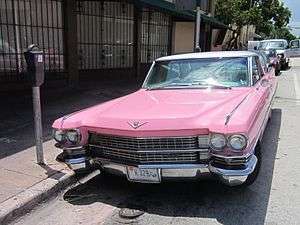
Pink is sometimes associated with extravagance and a wish to be noticed. A 1963 pink Cadillac.
-
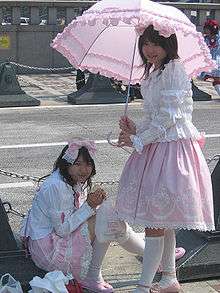
Pink and white together symbolize youth, tenderness and innocence.
Etymology and definitions
The color pink is named after the flowers called pinks, flowering plants in the genus Dianthus. The name derives from the frilled edge of the flowers—the verb "to pink" dates from the 14th century and means "to decorate with a perforated or punched pattern" (possibly from German pinken, "to peck").[6] While the word "pink" was first used as a noun to refer to a color in the 17th century, the verb "pink" continues to be reflected today in the name of those hand-held scissors that cut a zig-zagged line referred to as pinking shears.
History, art and fashion
From the Ancient history to the Early Modern

The color pink has been described in literature since ancient times. In the Odyssey, written in approximately 800 BCE, Homer wrote "Then, when the child of morning, rosy-fingered dawn appeared..."[7] Roman poets also described the color. Roseus is the Latin word meaning "rosy" or "pink." Lucretius used the word to describe the dawn in his epic poem On the Nature of Things (De rerum natura).[8]
Pink was not a common color in the fashion of the Middle Ages; nobles usually preferred brighter reds, such as crimson. However, it did appear in women's fashion, and in religious art. In the 13th and 14th century, in works by Cimabue and Duccio, the Christ child was sometimes portrayed dressed in pink, the color associated with the body of Christ.
In the high Renaissance painting the Madonna of the Pinks by Raphael, the Christ child is presenting a pink flower to the Virgin Mary. The pink was a symbol of marriage, showing a spiritual marriage between the mother and child.[9]
During the Renaissance, pink was mainly used for the flesh color of faces and hands. The pigment commonly used for this was called light cinabrese; it was a mixture of the red earth pigment called sinopia, or Venetian red, and a white pigment called Bianco San Genovese, or lime white. In his famous 15th century manual on painting, Il Libro Dell'Arte, Cennino Cennini described it this way: "This pigment is made from the loveliest and lightest sinopia that is found and is mixed and mulled with St. John’s white, as it is called in Florence; and this white is made from thoroughly white and thoroughly purified lime. And when these two pigments have been thoroughly mulled together (that is, two parts cinabrese and the third white), make little loaves of them like half walnuts and leave them to dry. When you need some, take however much of it seems appropriate. And this pigment does you great credit if you use it for painting faces, hands and nudes on walls..."[10]
-

In the early Renaissance, the infant Jesus was sometimes shown dressed in pink, the color associated with the body of Christ. This is the Virgin and Child Enthroned with Two Angels, by Cimabue. (1265–1280)
-
_-_WGA06706.jpg)
In the 1280s, Duccio also painted the Christ child dressed in pink
-

A knight in red receiving a helmet from a damsel in pink, from an English manuscript of The Romance of Alexander (1338-1344).
-

In the painting Madonna of the Pinks by Raphael, the Christ Child gives a pink flower to the Virgin Mary, symbolizing the union between the mother and child.
The 18th century
The golden age of the color pink was the Rococo Period (1720–1777) in the 18th century, when pastel colors became very fashionable in all the courts of Europe. Pink was particularly championed by Madame de Pompadour (1721–1764), the mistress of King Louis XV of France. who wore combinations of pale blue and pink, and had a particular tint of pink made for her by the Sevres porcelain factory, created by adding nuances of blue, black and yellow.[11]
While pink was quite evidently the color of seduction in the portraits made by George Romney of Emma, Lady Hamilton, the future mistress of Admiral Horatio Nelson, in the late 18th century, it had the completely opposite meaning in the portrait of Sarah Barrett Moulton painted by Thomas Lawrence in 1794. In this painting, it symbolized childhood, innocence and tenderness. Sarah Moulton was just eleven years old when the picture was painted, and died the following year.
-

Madame de Pompadour, the mistress of Louis XV of France, made pink and blue the leading fashion colors in the Court of Versailles. She had a special pink tint created for her by the Sevres porcelain factory. This portrait by Maurice Quentin de la Tour was painted between 1748 and 1755.
-

Pink had become a popular color throughout Europe by the late 18th century. It was associated with both romanticism and seduction. This fashion plate is from 1778–1787.
-
_3.jpg)
Emma, Lady Hamilton, later the mistress of Admiral Horatio Nelson, had herself painted by English painter George Romney posing as a Bacchante, dressed in pink. (1782–1784)
-
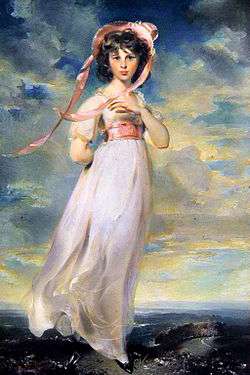
The portrait of Sarah Moulton, popularly known as "Pinkie", by Sir Thomas Lawrence (1794). Here pink represented youth, innocence and tenderness.
The 19th century
In 19th century England, pink ribbons or decorations were often worn by young boys; boys were simply considered small men, and while men in England wore red uniforms, boys wore pink. In fact the clothing for children in the 19th century was almost always white, since, before the invention of chemical dyes, clothing of any color would quickly fade when washed in boiling water. Queen Victoria was painted in 1850 with her seventh child and third son, Prince Arthur, who wore white and pink.
-

Queen Victoria in 1850 or 1851 with her third son and seventh child, Prince Arthur. In the 19th century, baby boys often wore white and pink. Pink was seen as a masculine color, while girls often wore white and blue.
-
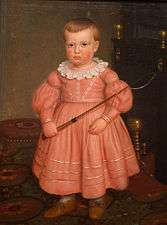
Young boy in pink, American school of painting (about 1840). Both girls and boys wore pink in the 19th century.
-

The Impressionist painter Claude Monet used pink, blue and green to capture the effects of light and shadows on a white dress in Springtime (1872).
-

Francisca of Brazil, Princess of Joinville, wearing a pink dress decorated with pink roses, 1850s. Painting by Franz Xaver Winterhalter.
The 20th century
In the 20th century, pinks became bolder, brighter, and more assertive, in part because of the invention of chemical dyes which did not fade. The pioneer in the creation of the new wave of pinks was the Italian designer Elsa Schiaparelli, (1890-1973) who was aligned with the artists of the surrealist movement, including Jean Cocteau. In 1931 she created a new variety of the color, called Shocking pink, made by mixing magenta with a small amount of white. She launched a perfume called Shocking, sold in a bottle in the shape of a woman's torso, said to be modelled on that of Mae West. Her fashions, co-designed with artists such as Cocteau, featured the new pinks.[12]
In Nazi Germany in the 1930s and 1940s, inmates of Nazi concentration camps who were accused of homosexuality were forced to wear a pink triangle.[13] Because of this, the pink triangle has become a symbol of the modern gay rights movement.[14]
The transition to pink as a sexually differentiating color for girls occurred gradually, through the selective process of the marketplace, in the 1930s and 40s. In the 1920s, some groups had been describing pink as a masculine color, an equivalent of the red that was considered to be for men, but lighter for boys. But stores nonetheless found that people were increasingly choosing to buy pink for girls, and blue for boys, until this became an accepted norm in the 1940s.[15][16]

The US presidential inauguration of Dwight D. Eisenhower in 1953 when Eisenhower's wife Mamie Eisenhower wore a pink dress as her inaugural gown is thought[17] to have been a key turning point to the association of pink as a color associated with girls. Mamie's strong liking of pink led to the public association with pink being a color that "ladylike women wear."[17] The 1957 American musical Funny Face also played a role in cementing the color's association with women.[17]
In 1973, Sheila Levrant de Bretteville created "Pink," a broadside (poster) meant to explore the notions of gender as associated with the color pink, for an American Institute of Graphic Arts exhibition about color. This was the only entry about the color pink. Various women including many in the Feminist Studio Workshop at the Woman's Building submitted entries exploring their association with the color. De Bretteville arranged the squares of paper to form a "quilt" from which posters were printed and disseminated throughout Los Angeles.[18] She was often called "Pinky" as a result.
Christo and Jeanne-Claude's Surrounded Islands wrapped wooded islands in Miami's Biscayne Bay with 6,500,000 sq ft (600,000 m2) of bright pink fabric.[19] Thomas von Taschitzki has said that "the monochrome pink wrappings"..."form a counterpoint to the small green wooded islands."[20]
Many of Franz West's aluminium sculptures were often painted a bright pink, for example Sexualitätssymbol (Symbol of Sexuality). West has said that the pink was intended as an "outcry to nature".[21]
-

Shocking pink was a new and more assertive pink invented by Italian fashion designer Elsa Schiaparelli in 1931, by mixing a little white with magenta. It became her signature color.
-
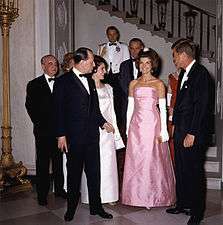
Jacqueline Kennedy, the wife of President John F. Kennedy, made pink a popular high-fashion color. Here she is in 1962 with French Minister of Culture Andre Malraux at the unveiling of the Mona Lisa on its first visit to America.
-

Detail of "Pink," a poster created by Sheila de Bretteville in 1973. It was meant to explore the notions of gender as associated with the color pink, for an American Institute of Graphic Arts exhibition about color.
-
.jpg)
Pink combined with black or violet is associated with seduction. Marilyn Monroe in the trailer for the film Gentlemen Prefer Blondes (1953).
-
.jpg)
Fairies are often depicted as wearing pink in fiction.
Science and nature
Optics
In optics, the word "pink" can refer to any of the colors between bluish red (purple) and red, of medium to high brightness and of low to moderate saturation.[22] Although pink is generally considered a tint of red,[23][24] most variations of pink lie between red, white and magenta colors. This means that the pink's hue is between red and magenta.[25][26][27][28]
Why sunrises and sunsets sometimes look pink
As a ray of white sunlight travels through the atmosphere, some of the colors are scattered out of the beam by air molecules and airborne particles. This is called Rayleigh scattering. Colors with a shorter wavelength, such as blue and green, scatter more strongly, and are removed from the light that finally reaches the eye.[29] At sunrise and sunset, when the path of the sunlight through the atmosphere to the eye is longest, the blue and green components are removed almost completely, leaving the longer wavelength orange, red and pink light. The remaining pinkish sunlight can also be scattered by cloud droplets and other relatively large particles, which give the sky above the horizon a pink or reddish glow.[30]
-

Sunrise in southeast Alaska. Sunsets and sunrises are sometimes pink because of an optical effect called Rayleigh scattering.
-

Sunset in Santa Monica, California.
Geology
-

Pink topaz from Ouro Preto, Brazil.
-

Barite-Rhodochrosite from the Guangxi Zhuang Autonomous Region in China.
-

The dunes in Coral Pink Sand Dunes State Park in Utah are made of fine grains of Navajo sandstone. The pink color comes from grains of reddish hematite mixed with white quartz.
-

Angel's Landing in Zion National Park in Utah is made of pink sandstone.
-
A pink sand beach on Great Santa Cruz Island in the Philippine Islands.
Biology
-

A Strigilla carnaria shell from Dominica, in the West Indies.
-

An Ocelated frogfish (Antennarius ocellatus), from East Timor. The frogfish is camouflaged to look like a rock covered with algae or seaweed; it lies motionless and waits for its prey to come to it.
-

The pink iguana of the Galapagos Islands was first identified in 1986 and first recognized as a distinct species in 2009.
-

The Pink Dolphin is a freshwater river dolphin which lives in the Orinoco, Amazon and Araguaia/Tocantins River systems of Brazil, Bolivia, Peru, Ecuador, Colombia and Venezuela. It is an endangered species and has a brain 40% larger than a human's.
-

The so-called "white elephant" is revered in several countries in Southeast Asia and is naturally pinkish gray. They are actually albino elephants.
-

Flamingoes in Laguna Colorada, Bolivia. The pink or reddish color of flamingos comes from carotenoid proteins in their diet of animal and plant plankton. A unhealthy or malnourished flamingo, or one kept in captivity and not fed sufficient carotene, is usually pale or white.
-
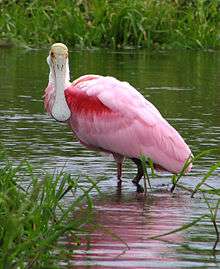
A Roseate Spoonbill in Myakka River State Park in Florida. Its pink color, like that of the flamingo, comes from the carotenoid pigments in its diet.
-

The Lophochroa leadbeateri, commonly known as Major Mitchell's Cockatoo or the pink cockatoo, is a native of the arid interior regions of Australia.
Why cooked beef, cured ham, steamed shrimp and salmon are pink
Raw beef is red, because the muscles of vertebrate animals, such as cows and pigs, contain a protein called myoglobin, which binds oxygen and iron atoms. When beef is cooked, the myoglobin proteins undergo oxidation, and gradually turn from red to pink to brown; that is, from rare to medium to well-done. Pork contains less myoglobin than beef and therefore is less red; when heated, it changes from pinkish-red to less pink to tan or white.
Ham, though it contains myoglobins like beef, undergoes a different transformation. Traditional hams, such as prosciutto, are made by taking the hind leg or thigh of a pig, covering it with sea salt, which removes the moisture content, and then letting it dry or cure for as long as two years. The salt (sodium nitrate) permits the ham to retain its original pink color, even when dried out. Supermarket hams are made by a different and faster process; they are brined, or infused with a salt-water solution, containing sodium nitrite, which transfers nitric oxide, which bonds with the myoglobin to form the traditional pink cured ham color.
The shells and flesh of crustaceans such as crabs, lobsters and shrimp contain a pink carotenoid pigment called astaxanthin. Their shells, naturally blue-green, turn pink or red when cooked. The flesh of the salmon also contains astaxanthins, which makes it pink. Farm-bred salmon are sometimes fed these pigments to improve their pinkness, and it is sometimes also used to enhance the color of egg yolks.
-
Roast beef gets its distinctive pink color from myoglobin, which gradually turns from red to pink to brown (rare to medium to well-done) when heated.
-

Prosciutto hams also get their pink color from salt combined with the natural protein called myoglobin.
-

The shells and flesh of steamed shrimp contain a natural carotenoid pigment called astaxanthin, which turns pink when heated. The same process turns cooked lobster and crab from blue-green to red when they are boiled.
-
The meat of the salmon is also colored pink by the natural carotenoid pigment called astaxanthin.
Plants and flowers
Pink is one of the most common colors of flowers; it serves to attract the insects and birds necessary for pollination and perhaps also to deter predators. The color comes from natural pigments called anthocyanins, which also provide the pink in raspberries.
-
.jpg)
A pink rose in the rain.
-
A clematis Chantilly.
-
.jpg)
A pink hibiscus from Australia.
-
Pink tulips in the botanical gardens of Moscow State University.
-
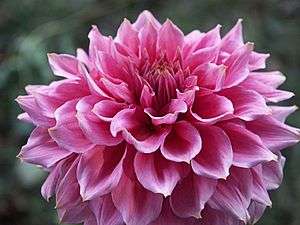
A pink dahlia
-
A pink peony.
-
A flower of a magnolia tree
-
A pink rhododendron
-

Spiraea japonica flowers.
-

A Japanese cherry tree (Prunus serrulata) in bloom.
-
Pink hyacinth flowers
Pigments - Pinke
In the 17th century, the word pink or pinke was also used to describe a yellowish pigment, which was mixed with blue colors to yield greenish colors. Thomas Jenner's A Book of Drawing, Limning, Washing (1652) categorizes "Pink & blew bice" amongst the greens (p. 38),[31] and specifies several admixtures of greenish colors made with pink—e.g. "Grasse-green is made of Pink and Bice, it is shadowed with Indigo and Pink … French-green of Pink and Indico [shadowed with] Indico" (pp. 38–40). In William Salmon's Polygraphice (1673), "Pink yellow" is mentioned amongst the chief yellow pigments (p. 96), and the reader is instructed to mix it with either Saffron or Ceruse for "sad" or "light" shades thereof, respectively.
Sonics
- Pink noise (
 sample ), also known as 1/f noise, in audio engineering is a signal or process with a frequency spectrum such that the power spectral density is proportional to the reciprocal of the frequency.
sample ), also known as 1/f noise, in audio engineering is a signal or process with a frequency spectrum such that the power spectral density is proportional to the reciprocal of the frequency.
Lighting
- Grow lights often use a combination of red and blue wavelengths, which generally appear pink to the human eye.[32]
- Pink neon signs are generally produced using one of two different methods. One method is to use neon gas and a blue or purple phosphor, which generally produces a warmer (more reddish) or more intense shade of pink. Another method is to use an argon/mercury blend and a red phosphor, which generally produces a cooler (more purplish) or softer shade of pink.
- Pink LEDs can be produced using two methods, either with a blue LED using two phosphors (yellow for the first phosphor, and red, orange, or pink for the second), or by placing a pink dye on top of a white LED. Color shifting was a common issue with early pink LEDs, where the red, orange, or pink phosphors or dyes faded over time, causing the pink color to eventually shift towards white or blue. These issues have been mitigated by the more recent introduction of more fade-resistant phosphors.
Engineering
- Insulation manufactured by Owens Corning is dyed pink, with The Pink Panther as its corporate mascot. The company holds a trademark on the color pink for insulation products in order to prevent competitors from using it, and is the first company in the United States to trademark a color.[33]
- The United States Manual on Uniform Traffic Control Devices specifies fluorescent pink as an optional color for traffic signs used for incident management as an alternative to the traditional orange in order to distinguish them from construction zone signs.[34]
Pink in symbolism and world culture
Common associations and popularity
According to public opinion surveys in Europe and the United States, pink is the color most associated with charm, politeness, sensitivity, tenderness, sweetness, softness, childhood, the feminine, and the romantic.[35] Although it did not have any strong negative associations in these surveys, few respondents chose pink as their favorite color. Pink was the favorite color of only two-percent of respondents, compared with forty-five-percent who chose blue.[36] Pink was the least-favorite color of seventeen percent of respondents; the only color more disliked was brown, with twenty percent. There was a notable difference between men and women; three percent of women chose pink as their favorite color, compared with less than one percent of men. Many of the men surveyed were unable to even identify pink correctly, confusing it with mauve. Pink was also more popular with older people than younger; twenty-five percent of women under twenty-five called pink their least favorite color, compared with only eight percent of women over fifty. Twenty-nine percent of men under the age of twenty-five said pink was their least favorite color, compared with eight percent of men over fifty.[37]
In Japan, pink is the color most commonly associated with springtime due to the blooming cherry blossoms.[38][39] This is different from surveys in the United States and Europe where green is the color most associated with springtime.
Pink in other languages
In many languages, the color pink is the name of the rose flower; like rose in French; roze in Dutch; rosa in German, Latin, Portuguese, Catalan, Spanish and Italian; rozoviy in Russian; różowy in Polish; and گلابی gulabi in Urdu.
In the Japanese language, the traditional word for pink, momo-iro (ももいろ), takes its name from the peach blossom. There is a separate word for the color of the cherry blossom: sakura-iro. In recent times a word based on the English version, pinku (ピンク), has begun to be used.
In Chinese, the color pink is named with a compound noun 粉紅色, meaning "powder red" where the powder refers to substances used for women's make-up.
Idioms and expressions
- In the pink. To be in top form, in good health, in good condition. In Romeo and Juliet, Mercutio says; "I am the very pink of courtesy." Romeo: Pink for flower? Mercutio: Right. Romeo: Then my pump is well flowered."[40]
- To see pink elephants means to hallucinate from alcoholism. The expression was used by American novelist Jack London in his book John Barleycorn in 1913.
- Pink slip. To be given a pink slip means to be fired or dismissed from a job. It was first recorded in 1915 in the United States.
- The phrase "pink-collar worker" refers to persons working in jobs conventionally regarded as "women's work."
- Pink Money, the pink pound or pink dollar is an economic term which refers to the spending power of the LGBT community.[41] Advertising agencies sometimes call the gay market the pink economy.
- Tickled pink means extremely pleased.
Architecture
Early pink buildings were usually built of brick or sandstone, which takes its pale red color from hematite, or iron ore. In the 18th century - the golden age of pink and other pastel colors - pink mansions and churches were built all across Europe. More modern pink buildings usually use the color pink to appear exotic or to attract attention.
-

Malbork Castle in Poland, built by the Teutonic Knights in 1440, is the largest brick structure in the world.
-

Casa Rosada, or the "Pink House", in Buenos Aires, built between 1713 and 1855 as a fort and then customs house, is the official residence and office of the President of Argentina.
-

The City Center in Kannur, India.
-

Ostankino Palace, outside of Moscow, is an 18th-century country house built by Pyotr Sheremetev, then the richest man in Russia.
-
Macau Government Headquarters (1849), an example of Portuguese colonial architecture and the Pombaline style in Macau.
-

The Royal Hawaiian Hotel in Honolulu, Hawaii, built in 1927, was the first hotel on Waikiki Beach. Its pink color was designed to match an exotic setting, and to contrast with the blue of the sea and green of the landscape.
-

The Georgia-Pacific Tower in Atlanta, Georgia (1981), a modernist pink skyscraper.
-

Canada Place Building, in Edmonton, Alberta, Canada (1988) a post-modernist style government office building.
Food and beverages
According to surveys in Europe and the United States, pink is the color most associated with sweet foods and beverages. Pink is also one of the few colors to be strongly associated with a particular aroma, that of roses.[42] Many strawberry and raspberry-flavored foods are colored pink and light red as well, sometimes to distinguish them from cherry-flavored foods that are more commonly colored dark red (although raspberry-flavored foods, particularly in the United States, are often colored blue as well). The drink Tab was packaged in pink cans, presumably to subconsciously convey a sweet taste.
The pink color in most packaged and processed foods, ice creams, candies and pastries is made with artificial food coloring. The most common pink food coloring is erythrosine, also known as Red No. 3, an organoiodine compound, a derivative of fluorone, which is a cherry-pink synthetic.[43] It is usually listed on package labels as E-127. Another common red or pink (particularly in the United States where erythrosine is less frequently used) is Allura Red AC (E-129), also known as Red No. 40. Some products use a natural red or pink food coloring, Cochineal, also called carmine, made with crushed insects of the family Dactylopius coccus.
-

Pink is the color most commonly associated with sweet tastes.
-
.jpg)
A strawberry ice cream cone. Strawberry is the fourth most popular ice cream flavor in the U.S., after vanilla, chocolate, and butter pecan.[1]
-

Cotton candy was first made for the French Royal Court in the 18th century, but did not become popular until the beginning of the 20th century, when an American dentist invented a machine for spinning it quickly and cheaply.
-

A macaron with raspberries
-

Bunga kuda (also known as bunga pundak) is a traditional dessert in Malaysia, containing a coconut filling.
-

Chi chi dango is a sweet dessert made of rice flour. It is of Japanese origin, and very popular in Hawaii.
-

Pink champagne takes its color either by being fermented for a short time with the skins of dark purple grapes, or by the addition of a small amount of red wine.
- ^ Reported by Food Channel Editor site, July 30, 2008. Source: the International Ice Cream Association, 888 16th Street, Washington DC.
Gender

In Europe and the United States, pink is often associated with girls, while blue is associated with boys. These colors were first used as gender signifiers just prior to World War I (for either girls or boys), and pink was first established as a female gender signifier in the 1940s.[44][45] In the 20th century, the practice in Europe varied from country to country, with some assigning colors based on the baby's complexion, and others assigning pink sometimes to boys and sometimes to girls.[46]
Many have noted the contrary association of pink with boys in 20th-century America. An article in the trade publication Earnshaw's Infants' Department in June 1918 said:
The generally accepted rule is pink for the boys, and blue for the girls. The reason is that pink, being a more decided and stronger color, is more suitable for the boy, while blue, which is more delicate and dainty, is prettier for the girl.[47][48][49][50][51]
One reason for the increased use of pink for girls and blue for boys was the invention of new chemical dyes, which meant that children's clothing could be mass-produced and washed in hot water without fading. Prior to this time, most small children of both sexes wore white, which could be frequently washed.[52] Another factor was the popularity of blue and white sailor suits for young boys, a fashion that started in the late 19th century. Blue was also the usual color of school uniforms, for boys and girls. Blue was associated with seriousness and study, while pink was associated with childhood and softness.
By the 1950s, pink was strongly associated with femininity but to an extent that was "neither rigid nor universal" as it later became.[53][54][55]
One study by two neuroscientists in Current Biology examined color preferences across cultures and found significant differences between male and female responses. Both groups favored blues over other hues, but women had more favorable responses to the reddish-purple range of the spectrum and men had more favorable responses to the greenish-yellow end of the spectrum. Despite the fact that the study used adults, and both groups preferred blues, and responses to the color pink were never even tested, the popular press represented the research as an indication of an innate preference by girls for pink. The misreading has been often repeated in market research, reinforcing American culture's association of pink with girls on the basis of imagined innate characteristics.[56]
Toys aimed at girls often display pink prominently on packaging and the toy themselves. In its 1957 catalog, Lionel Trains offered for sale a pink model freight train for girls. The steam locomotive and coal car were pink and the freight cars of the freight train were various pastel colors. The caboose was baby blue. It was a marketing failure because any girl who might want a model train would want a realistically colored train, while boys in the 1950s did not want to be seen playing with a pink train. However, today it is a valuable collector's item.[57]
As of 2008 various feminist groups and the Breast Cancer Awareness Month use the color pink to convey empowerment of women.[58] Breast cancer charities around the world have used the color to symbolize support for people with breast cancer and promote awareness of the disease. A key tactic of these charities is encouraging women and men to wear pink[59] to show their support for breast cancer awareness and research.
Pink has symbolized a "welcome embrace" in India and masculinity in Japan.[58]
-

In the United States and Europe, baby girls are often dressed in pink and white.
-
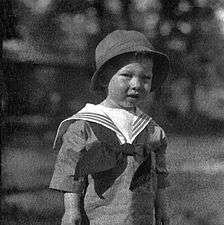
Boy in a sailor suit (1920). The blue sailor suit helped make blue instead of pink the color for boys in the 20th century.
-
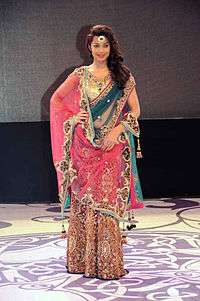
Indian actress Mugdha Godse. In many cultures, pink is associated with femininity.
-

Women of the Herero people from Namibia. Pink stands out.
Sexuality
As noted above, pink combined with black or violet is commonly associated with eroticism and seduction.
- In street slang, the pink sometimes refers to the vagina.[60]
- In Russian, pink (розовый, rozovyj) is used to refer to lesbians, and light blue (голубой, goluboj) refers to gay men.[61]
- In Japan, a genre of low budget, erotic cinema is referred to as Pink films (ピンク映画 Pinku Eiga).[62]
Politics

- Pink, being a 'watered-down' red, is sometimes used in a derogatory way to describe a person with mild communist or socialist beliefs (see Pinko).
- The term pink revolution is sometimes used to refer to the overthrow of President Askar Akayev and his government in the Central Asian republic of Kyrgyzstan after the parliamentary elections of February 27 and of March 13, 2005, although it is more commonly called the tulip revolution.
- The Swedish feminist party Feminist Initiative uses pink as their color.
- Code Pink is an American women's anti-globalization and anti-war group founded in 2002 by activist Medea Benjamin. The group has disrupted Congressional hearings and heckled President Obama at his public speeches.
- It was a common practice to color British Empire pink on maps.[63]
Social movements
Pink is often used as a symbolic color by groups involved in issues important to women, and the lesbian, gay, bisexual and transsexual people.
- A Dutch newsgroup about homosexuality is called nl.roze (roze being the Dutch word for pink), while in Britain, Pink News is a gay newspaper and online news service. There is a magazine called Pink for the lesbian, gay, bisexual and transgender (LGBT) community which has different editions for various metropolitan areas.[64] In France Pink TV is an LGBT cable channel.
- In Ireland, Support group for Irish Pink Adoptions defines a pink family as a relatively neutral umbrella term for the single gay men, single lesbians, or same-gender couples who intend to adopt, are in the process of adopting, or have adopted. It also covers adults born/raised in such families. The group welcome the input of other people touched by adoption, especially people who were adopted as children and are now adults.[65]
- Pinkstinks, a campaign founded in London in May 2008[66] to raise awareness of what they claim is the damage caused by gender stereotyping of children.[67][68]
- The Pink Pistols is a gay gun rights organization.[69]
- The pink ribbon is the international symbol of breast cancer awareness. Pink was chosen partially because it is so strongly associated with femininity.[70]
-

The pink ribbon has been a symbol of breast cancer awareness since 1991.
-
.jpg)
The National Congress of Brazil lit up in pink for Breast Cancer Awareness Month on October 1, 2014.
Academic dress
- In the French academic dress system, the five traditional fields of study (Arts, Science, Medicine, Law and Divinity) are each symbolized by a distinctive color, which appears in the academic dress of the people who graduated in this field. Redcurrant, an extremely red shade of pink, is the distinctive color for Medicine (and other health-related fields) fr:Groseille (couleur).
Heraldry
The word pink is not used for any tincture (color) in heraldry, but there are two fairly uncommon tinctures which are both close to pink:
- The heraldic color of rose is a modern innovation, mostly used in Canadian heraldry, depicting a reddish pink color like the shade usually called rose.
- In French heraldry, the color carnation is sometimes used, corresponding to the skin color of a light skinned Caucasian human. This can also be seen as a pink shade but is usually depicted slightly more brownish beige than the rose tincture.
Calendars
- In Thailand, pink is associated with Tuesday on the Thai solar calendar. Anyone may wear pink on Tuesdays, and anyone born on a Tuesday may adopt pink as their color.
The press
Pink is used for the newsprint paper of several important newspapers devoted to business and sports, and the color is also connected with the press aimed at the gay community.
Since 1893 the London Financial Times newspaper has used a distinctive salmon pink color for its newsprint, originally because pink dyed paper was less expensive than bleached white paper.[71] Today the color is used to distinguish the newspaper from competitors on a press kiosk or news stand. In some countries, the salmon press identifies economic newspapers or economics sections in "white" newspapers. Some sports newspapers, such as La Gazzetta dello Sport in Italy, also use pink paper to stand out from other newspapers. It awards a pink jersey to the winner of Italy's most important bicycle race, the Giro d'Italia. (See #Sports).
-

The Pink News is a newspaper for the Gay community in Britain.
Law
- In England and Wales, a brief delivered to a barrister by a solicitor is usually tied with pink ribbon. Pink was traditionally the color associated with the defense, while white ribbons may have been used for the prosecution.[72]
Literature
- In Spanish and Italian, a "pink novel" (novela rosa in Spanish, romanzo rosa in Italian) is a sentimental novel marketed to women.
- In Nathaniel Hawthorne's Young Goodman Brown, Faith is wearing a pink ribbon in her hair which represents her innocence.[73]
- Carl Surely's short story "Dinsdale's Pink" is a coming of age tale of a young man growing up in Berlin in the 1930s, dealing with issues of gender, sexuality and politics.
Religion
- In the Yogic Hindu, Shaktic Hindu and Tantric Buddhist traditions rose is one of the colors of the fourth primary energy center, the heart chakra Anahata. The other color is green.
- In Catholicism, pink (called rose by the Catholic Church) symbolizes joy and happiness. It is used for the Third Sunday of Advent and the Fourth Sunday of Lent (see Laetare Sunday) to mark the halfway point in these seasons of penance. For this reason, one of the candles in an Advent wreath may be pink, rather than purple.
- Pink is the color most associated with Indian spiritual leader Meher Baba, who often wore pink coats to please his closest female follower, Mehera Irani, and today pink remains an important color, symbolizing love, to Baba's followers.
Sports
- In Major League Baseball, pink bats are used by baseball players on Mother's Day as part of a week-long program to benefit Susan G. Komen for the Cure.
- Pink can mean the scarlet coat worn in fox hunting (a.k.a. "riding to hounds"). One legend about the origin of this meaning refers to a tailor named Pink (or Pinke, or Pinque).
- The leader in the Giro d'Italia cycle race wears a pink jersey (maglia rosa); this reflects the distinctive pink-colored newsprint of the sponsoring Italian La Gazzetta dello Sport newspaper.
- The University of Iowa's Kinnick Stadium visitors' locker room is painted pink. The decor has sparked controversy, perceived by some people as suggesting sexism and homophobia.[74]
- Palermo, a soccer team based in Palermo, Italy, traditionally wears pink home jerseys.
- WWE Hall of Famer Bret Hart, as well as other members of the Hart wrestling family, is known for his pink and black wrestling attire.
- The Western Hockey League team Calgary Hitmen originally wore pink as a tribute to the aforementioned Bret Hart, who was a part team owner at the time.
- The Penrith Panthers of the NRL, wear a pink away jersey.
-
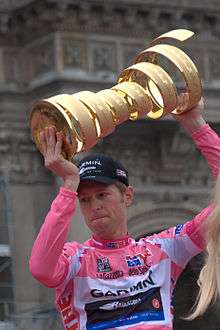
The leader in the Giro d'Italia cycle race wears a pink jersey (maglia rosa)
See also
- Baker-Miller Pink
- Fuchsia (color)
- List of colors
- Pinkstinks
- Rosé, a wine whose color is neither red nor white
- Shades of pink
References
Further reading
- Heller, Eva (2009). Psychologie de la couleur – Effets et symboliques. Pyramyd (French translation). ISBN 978-2-35017-156-2.
- Broecke, Lara (2015). Cennino Cennini's Il Libro dell'Arte: a New English Translation and Commentary with Italian Transcription. Archetype. ISBN 978-1-909492-28-8.
- Boston Museum of Fine Arts, Think Pink, 2014. Exhibition Link
- Susan Stamberg/NPR, "Girls Are Taught To 'Think Pink,' But That Wasn't Always So, 2014. Story link.
Notes and citations
- ↑ "W3C TR CSS3 Color Module, HTML4 color keywords". W3.org. Retrieved 2010-09-11.
- ↑ Shorter Oxford English Dictionary, 5th Edition, Oxford University Press.
- ↑ Webster New World Dictionary, Third College Edition: "Any of a genus (Dianthus) of annual and perennial plants of the pink family with white, pink or red flowers.; its pale red color."
- ↑ Heller, Eva: Psychologie de la couleur – effets et symboliques, pp. 179-184
- ↑ "pink, n.⁵ and adj.²", Oxford English Dictionary Online
- ↑ Collins Dictionary
- ↑ The Odyssey, Book XII, translated by Samuel Butler.
- ↑ "CTCWeb Glossary: R (ratis to ruta)". Ablemedia.com. Retrieved 2010-09-11.
- ↑ http://www.nationalgallery.org.uk/cgi-bin/WebObjects.dll/CollectionPublisher.woa/wa/work?workNumber=NG6596 The Madonna of the Pinks on the official National Gallery website
- ↑ Lara Broecke, Cennino Cennini's Il Libro dell'Arte: a New English Translation and Commentary with Italian Transcription, Archetype 2015, p. 62.
- ↑ Eva Heller, Psychologie de la couleur, effets et symboliques, pp. 182-83
- ↑ Eva Heller, Psychologie de la couleur - effets et symboliques, p. 184.
- ↑ The Pink Triangle: The Nazi War Against Homosexuals (1986) by Richard Plant (New Republic Books). ISBN 0-8050-0600-1.
- ↑ McCormick, Joseph Patrick. "Nick Clegg calls for gay victims of the Nazis to be remembered in national Holocaust memorial". Pink Triangle. Retrieved 19 September 2015.
- ↑ Smithsonian Magazine
When Did Girls Start Wearing Pink?
In 1927, Time magazine printed a chart showing sex-appropriate colors for girls and boys according to leading U.S. stores. In Boston, Filene’s told parents to dress boys in pink. So did Best & Co. in New York City, Halle’s in Cleveland and Marshall Field in Chicago.Today’s color dictate wasn’t established until the 1940s, as a result of Americans’ preferences as interpreted by manufacturers and retailers. “It could have gone the other way”
- ↑ Stamberg, Susan (April 1, 2014). "Girls Are Taught To 'Think Pink,' But That Wasn't Always So". npr.org. NPR. Archived from the original on 2014-04-15. Retrieved 2014-09-26.
a 1918 trade catalog for children's clothing recommended blue for girls. The reasoning at the time was that it's a 'much more delicate and dainty tone,' Finamore says. Pink was recommended for boys 'because it's a stronger and more passionate color, and because it's actually derived from red.'
- 1 2 3 Jennifer Wright (14 April 2015). "How did pink become a girly color?". Vox. Retrieved 9 August 2015.
- ↑ "WACK! Exhibition, podcast interview with de Bretteville". MOCA.org. 1940-11-04. Retrieved 2010-09-27.
- ↑ Goodman, Walter (1987-10-16). "Film: Christo, in 'Islands'". The New York Times. Retrieved 2007-10-05.
- ↑ Nemitz, Barbara; Fuse, Hideto (2006). Pink The Exposed Color in Contemporary Art and Culture. New York: Ostfildern:Hatje Cantz. p. 68.
- ↑ Nemitz, Barbara. Pink The Exposed Color in Contemporary Art and Culture. Hatje Cantz. p. 69.
- ↑ "Merriam Webster definition of the color "pink"". merriam-webster.com. Retrieved 2011-11-12.
- ↑ "Pink, a Tint of Red". Landscape-guide.com. Retrieved 2010-09-11.
- ↑ "For example, pink is a tint of red". Enchantedlearning.com. Retrieved 2010-09-11.
- ↑ Colors by Hue at MSDN
- ↑ "Creating Styles in Fireworks". Adobe.com. 2009-07-14. Archived from the original on July 26, 2008. Retrieved 2010-09-11.
- ↑ Dana Lee Ling. "x11 Colors in Hue Saturation Luminosity order". Comfsm.fm. Retrieved 2010-09-11.
- ↑ "Color Names". ImageMagick. 2010-01-02. Retrieved 2010-09-11.
- ↑ K. Saha (2008). The Earth's Atmosphere - Its Physics and Dynamics. Springer. p. 107. ISBN 978-3-540-78426-5.
- ↑ B. Guenther (ed.) (2005). Encyclopedia of Modern Optics. Vol. 1. Elsevier. p. 186.
- ↑ Jenner, Thomas (1652). A Book of Drawing, Limning, Washing. London: M. Simmons. p. 38.
- ↑ "Indoor Vertical Farm 'Pinkhouses' Grow Plants Faster With Less Energy". Inhabitat. Retrieved November 16, 2015.
- ↑ "Color Branding & Trademark Rights". Color Matters. Retrieved August 3, 2016.
- ↑ "MUTCD 2009 Edition Chapter 6F. Temporary Traffic Control Zone Devices". Federal Highway Administration. Retrieved August 3, 2016.
- ↑ Eva Heller, Psychologie de la couleur - effets et symboliques, p. 179-185
- ↑ Eva Heller, Psychologie de la couleur - effets et symboliques, p. 179.
- ↑ Eva Heller, Psychologie de la couleur - effets et symboliques, p. 179
- ↑ "Spring is Pink". SRI Threads. April 4, 2011. Retrieved January 7, 2016.
- ↑ "Season Colour – I Think Spring is Green". Calvin-C.com. Retrieved February 17, 2016.
- ↑ Romeo and Juliet, Act 2, Scene 4
- ↑ "Opportunities in the Pink Economy of the United Kingdom" (PDF). Archived from the original (PDF) on March 27, 2009. Retrieved 2010-09-11.
- ↑ Eva Heller, Psychologie de la couleur – effets et symboliques
- ↑ Phyllis A. Lyday "Iodine and Iodine Compounds" in Ullmann's Encyclopedia of Industrial Chemistry, 2005, Wiley-VCH, Weinheim
- ↑ Jo B. Paoletti, Pink and Blue: Telling the Girls From the Boys in America (Indiana University Press, 2012), 87
- ↑ Smithsonian, When Did Girls Start Wearing Pink?, April 2011
- ↑ "Is pink for girls or boys?". BBC Radio. 19 December 2009. Retrieved 1 October 2012.
- ↑ Smithsonian.com: Jeanne Maglaty, "When Did Girls Start Wearing Pink?," April 8, 2011, accessed June 4, 2011
- ↑ Merkin, Daphne. "Gender Trouble", The New York Times Style Magazine, March 12, 2006. Retrieved 10 December 2007.
- ↑ Orenstein, Peggy. "What's Wrong With Cinderella?", The New York Times Magazine, December 24, 2006, retrieved December 10, 2007. Orenstein writes: "When colors were first introduced to the nursery in the early part of the 20th century, pink was considered the more masculine hue, a pastel version of red. Blue, with its intimations of the Virgin Mary, constancy and faithfulness, was thought to be dainty. Why or when that switched is not clear, but as late as the 1930s a significant percentage of adults in one national survey held to that split."
- ↑ Jude Stewart (2008). "Pink is for Boys: cultural history of the color pink". Step Inside Design Magazine. Archived from the original on 2008-02-28.
- ↑ Kimmell, Michael. Manhood in America: A Cultural History, 1996, The Free Press. p.158
- ↑ Eva Heller, Psychologie de la couleur; effets et symboliques.
- ↑ Paoletti, 92
- ↑ Ben Goldacre (2007-08-25). "Bad Science". Out of the Blue and into the Pink. London.
- ↑ Zucker, Kenneth J. & Bradley, Susan J. (1995). Gender Identity Disorder and Psychosexual Problems in Children and Adolescents. Guilford Press. p. 203. ISBN 0-89862-266-2.
- ↑ Paoletti, 97-8
- ↑ "Lionel's 1957 pink train for girls:". Lionel-train-set.com. Retrieved 2012-12-07.
- 1 2 "Pink: The Color." "Part 2: Girl Culture A to Z" - In: Mitchell, Claudia and Jacqueline Reid-Walsh (editors). Girl Culture: Studying girl culture : a readers' guide or Girl Culture: An Encyclopedia Volume 1. ABC-CLIO (Greenwood Publishing Group), 2008. ISBN 0313339090, 9780313339097. p. 473. "It is important to note its significance to femininity as a Western phenomenon, because the color is a sign of masculinity in Japan and signifies a welcome embrace in India.[...]of pink with femininity has been strategically used in gendered terms to convey strength and pride: pink is the color of Breast Cancer Awareness Month, and many feminist groups have adopted the color pink as a sign of empowerment." - See Google Books search result
- ↑ "Real Men Wear Pink | NBCF". Real Men Wear Pink 2016 – The National Breast Cancer Foundation. Retrieved 2016-03-21.
- ↑ "What does pink mean? pink Definition". Retrieved 2012-10-29.
- ↑ "Gay in Russia". Gaylife. Retrieved September 5, 2012.
- ↑ "Pink thrills: Japanese sex movies go global | The Japan Times Online". Search.japantimes.co.jp. 2008-12-04. Retrieved 2010-08-16.
- ↑ "Why is the British Empire coloured pink on maps?". Royal Museums Greenwich. Archived from the original on October 6, 2015.
- ↑ "Website of Pink magazine:". Pinkmag.com. Retrieved 2010-09-11.
- ↑ irishpinkadoptions.com http://irishpinkadoptions.com. Missing or empty
|title=(help) - ↑ Katy Guest (18 December 2011). "Girls will be girls: The battle for our children's hearts and minds this Christmas". The Independent. London. Retrieved 13 April 2013.
- ↑ Susanna Rustin (21 April 2012). "Why girls aren't pretty in pink". The Guardian. London. Retrieved 13 April 2013.
- ↑ Harry Wallop (30 November 2009). "Pink toys 'damaging' for girls". Daily Telegraph. London. Retrieved 13 April 2013.
- ↑ "Pink Pistols website:". Pinkpistols.org. 2001-03-08. Retrieved 2010-09-11.
- ↑ Fernandez, Sandy (June–July 1998). "Pretty in Pink". Archived from the original on 2009-08-15. Retrieved 28 May 2013.
- ↑ Cited by Stephen Fidler of the Wall Street Journal, formerly a correspondent for the Financial Times.
- ↑ O'Riordain, Aoife (1998-10-03). "The evidence: The barrister's desk". The Independent. London.
- ↑ As he moves out of the darkness, a pink ribbon blows down next to him and he sees that Faith is part of the "communion" that is taking place in the woods.
- ↑ "Controversy regarding pink University of Iowa locker room:". Sports.espn.go.com. 2005-09-28. Retrieved 2010-09-11.
External links
| Look up in the pink in Wiktionary, the free dictionary. |


.jpg)


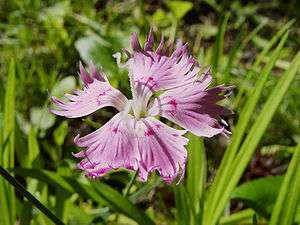









.jpg)